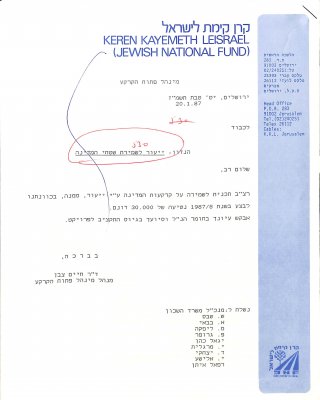Current clashes around the JNF’s work in the Negev cannot be understood outside the historical context of afforestation in Israel and its hidden objective: taking over land. Ever since the country’s inception, afforestation has been used as a way of gaining control of land and securing land reserves for Jewish settlement. A 1987 JNF plan entitled “Afforestation to Preserve State Land” perfectly illustrates this practice.
The term “afforestation” may sound romantic, but, for Israel, it is a term and practice used to mask the appropriation and takeover of lands both inside Israel and in the territories it controls. Minutes of a meeting held by the Settlement Committee in February 1979, chaired by the then Minister of Agriculture Ariel Sharon, candidly described practices used by the state to take over land in the Galilee – mass afforestation and the building of Mitzpim (small Jewish settlements): According to Sharon, these actions were designed to Judaize the Galilee and secure “land reserves for settlement activity for the next 20, 30 or 40 years.”
Why use afforestation? From the government’s perspective, the problem in the Galilee, as in other areas, was that the country did not have enough money for mass settlement and more importantly not enough Jewish citizens were prepared to move to the Galilee and “Judaize it” by building permanent communities.
About a decade later, in January 1987, Dr. Haim Zaban, who headed the Land Development Department of the JNF at the time, sent out a plan entitled “Afforestation to Preserve State Land.” This document also describes the proposed afforestation of tens of thousands of dunams of land as a tool for securing land reserves – this time in the occupied West Bank. Zaban wrote:
“Only 64% of the area north of Beersheba and up to the Lebanese border, including the Judea and Samaria Area, is held by the People of Israel. Preservation of these territories has receded in recent years. […] There are no chasms in the world of the Lord, and preservation of these territories must be exercised in practice” (emphasis added).
As Zaban noted in the letter addressed to the Director General of the Housing Ministry and other officials, the plan would see the afforestation of some 30,000 dunams of land in the 1987/8 work year, after many years of reduced afforestation efforts due to limited funding.
Another letter, written that same year by JNF Central District Forestry Manager Nathan Sass, describes another aspect of afforestation as a tool for land appropriation in the Occupied Territories. In a letter to Minister of Housing and Construction David Levy, Sass noted that some of the areas designated as “state land” in the Occupied Territories did not have zoning plans for either present or future use, and therefore, “a masterplan for afforestation has been prepared for areas lacking zoning.” In other words, afforestation was being used as a way of establishing ‘facts on the ground’ and taking over vast areas where no specific plans had been made yet, and no measures had been taken to secure control.













